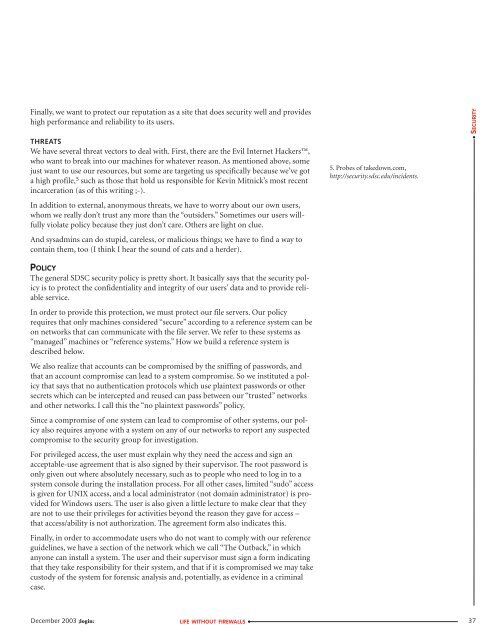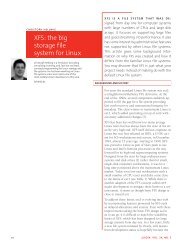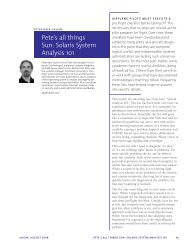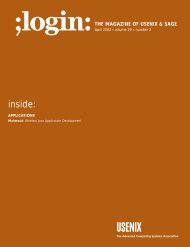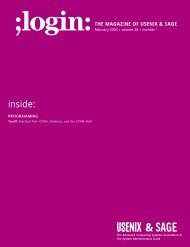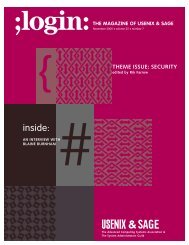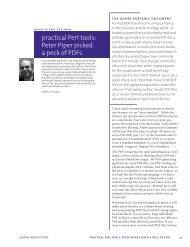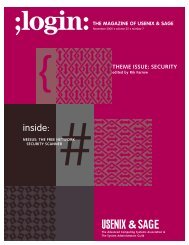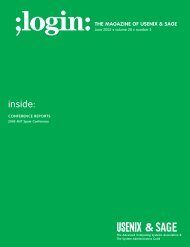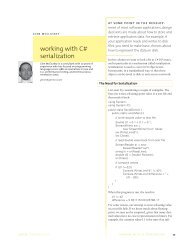inside: Focus Issue: Security
inside: Focus Issue: Security
inside: Focus Issue: Security
You also want an ePaper? Increase the reach of your titles
YUMPU automatically turns print PDFs into web optimized ePapers that Google loves.
Finally, we want to protect our reputation as a site that does security well and provideshigh performance and reliability to its users.THREATSWe have several threat vectors to deal with. First, there are the Evil Internet Hackers,who want to break into our machines for whatever reason. As mentioned above, somejust want to use our resources, but some are targeting us specifically because we’ve gota high profile, 5 such as those that hold us responsible for Kevin Mitnick’s most recentincarceration (as of this writing ;-).In addition to external, anonymous threats, we have to worry about our own users,whom we really don’t trust any more than the “outsiders.” Sometimes our users willfullyviolate policy because they just don’t care. Others are light on clue.And sysadmins can do stupid, careless, or malicious things; we have to find a way tocontain them, too (I think I hear the sound of cats and a herder).POLICYThe general SDSC security policy is pretty short. It basically says that the security policyis to protect the confidentiality and integrity of our users’ data and to provide reliableservice.In order to provide this protection, we must protect our file servers. Our policyrequires that only machines considered “secure” according to a reference system can beon networks that can communicate with the file server. We refer to these systems as“managed” machines or “reference systems.” How we build a reference system isdescribed below.We also realize that accounts can be compromised by the sniffing of passwords, andthat an account compromise can lead to a system compromise. So we instituted a policythat says that no authentication protocols which use plaintext passwords or othersecrets which can be intercepted and reused can pass between our “trusted” networksand other networks. I call this the “no plaintext passwords” policy.Since a compromise of one system can lead to compromise of other systems, our policyalso requires anyone with a system on any of our networks to report any suspectedcompromise to the security group for investigation.For privileged access, the user must explain why they need the access and sign anacceptable-use agreement that is also signed by their supervisor. The root password isonly given out where absolutely necessary, such as to people who need to log in to asystem console during the installation process. For all other cases, limited “sudo” accessis given for UNIX access, and a local administrator (not domain administrator) is providedfor Windows users. The user is also given a little lecture to make clear that theyare not to use their privileges for activities beyond the reason they gave for access –that access/ability is not authorization. The agreement form also indicates this.Finally, in order to accommodate users who do not want to comply with our referenceguidelines, we have a section of the network which we call “The Outback,” in whichanyone can install a system. The user and their supervisor must sign a form indicatingthat they take responsibility for their system, and that if it is compromised we may takecustody of the system for forensic analysis and, potentially, as evidence in a criminalcase.5. Probes of takedown.com,http://security.sdsc.edu/incidents.● SECURITYDecember 2003 ;login:LIFE WITHOUT FIREWALLS ●37


